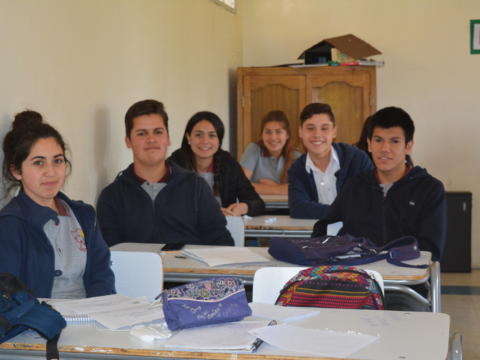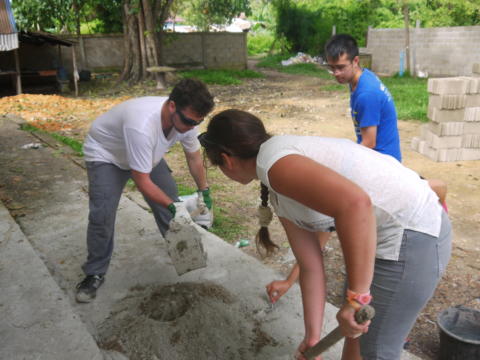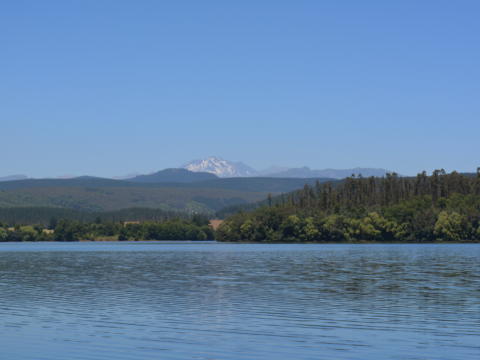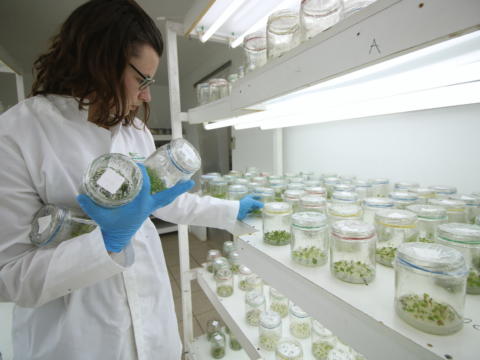Only 480€ per week!
English Teaching
Coihueco - Chile
Give back to the local rural community and spend time with the local students by teaching English at the schools in and around Coihueco.
Teaching in rural schools helps the students broaden their minds and will be a fulfilling experience for you. The way you get to teach is entirely up to you. You may create real-life scenarios, games and other activities with an English language focus. There is a lot of freedom for you to bring your creativity and teaching ideas into the classroom!
Program Description
This program consists of working with students at various schools teaching English. We have strong relationships with secondary and high schools in the area. English is hard for the local students and villagers and this is where your help is needed most. This program is a great way to improve the English knowledge in the area.
You will assist the teacher during english classes and follow the school curriculum. You will be able to play games with them or teach them an english song. The main aim is to speak as much english with the students as possible.
Our teaching program serves a dual purpose: Firstly, of course, it is meant to help children in Chile to have a chance to understand and speak more English. Secondly, it will give you an insight into the Chilean education system, while providing a good chance to become good friends with students and teachers.
Aims & Objectives
- Improve the English level of the youth of Chile and widen their cultural interactions
- Assist the school staff with extra hands
- Provide you with teaching experience, an invaluable life skill!
- Broaden your perspective to others that may not be as fortunate
Schedule
Monday to Friday
- Breakfast
- Teaching in the school
- Lunch
- Teaching in the school
- Prepare activities for the next day
- Dinner
Note: This schedule can be changed and/or amended depending on weather conditions, local conditions and unforeseen circumstances.
Participant Criteria & Requirements
Standard Requirements
Minimum age: –
Maximum age: –
Minimum English level: Basic
CRB required: On Signup
Passport copy required: No
Resume copy required: No
Required qualification: None
Additional Requirements
There are no further requirements for this program.
Additional Equipment
- You are more than welcome to bring teaching materials/resources for your class such as:
- Interesting board games
- English books/Comics/Pencils/Erasers
- Cultural items of interest
Location
You will be located in the outskirts of Coihueco, an interesting town 400 km South of Chile’s capital, Santiago. Coihueco is both a Chilean commune, and a city, in Ñuble Province, Biobío Region. The commune borders Argentina on the east and the provincial capital, Chillán, on the west.
Coihueco is known for their wood carvings and loom weaving, as well as their Festival of Creole Roots, which revives many folkloric traditions!
About the Accommodation
Your new home will be in a dormitory at a local school in Coihueco, central Chile. The accommodation has a communal area where you can eat, relax, meet fellow participants and use the free Wifi. During the school holidays December – March) and (Jun – Jul), the school dormitory will be closed so your new accommodation will be at a nearby home having access to the same amenities and food arrangements.
Food Arrangements
All the meals served inside the accommodation will be typically Chilean, including rice dishes, potatoes, beans, meat, sandwiches and vegetables. Water, coffee and tea are available all day long.
Facilities
There are ATMs, a bank, restaurants and even a mini-mall in the local village all located 10 minutes away by foot.
Activities & Events
No scheduled activities outside the program.
Sights & Surroundings
There are a lot of things for you to do over the weekends or on your free days. You can explore some amazing waterfalls, or even make your way to the Andes, hire some skis and enjoy the snow. Since the Andean Mountains are not that far away from Coihueco, it's a perfect trip to take over the weekend.
If you don’t feel like jumping on the skis, you can trek and enjoy the beautiful environment around you. There are also national parks and hot springs close to Coihueco for you to explore.
You can also choose to travel to Santiago, Chile’s capital, over the weekend. It usually takes about 6 hours by mini-van or bus from Coihueco.
Transportation
From this location we do not provide free transport to other locations.
Quick Facts
Name: Republic of Chile
Population: 18 million
Capital: Santiago
Language: Spanish
Currency: Peso (CLP)
Time zone: UTC -3 & -5
Country Information
Chile is a long, narrow country stretching along South America’s western edge with more than 6000 kilometer of Pacific Ocean coastline. Bordered by Peru in the north, Bolivia in the north-east and Argentina in the east. Today, Chile is one of South America’s most stable and healthy nations.
Chile has something for everyone. Go skiing in the Andes, surf big waves in the Pacific Ocean or go on a nice trek to one of the world's largest volcanoes. In this diverse country you can also find, Algarobbo City, the biggest pool in the world and the Atacama Desert, the driest place on earth, where it has never rained before. Here you will also find amazingly cute penguins and other wildlife.
Climate
Argentina’s climate varies from region to region due to the country’s long and narrow shape. Hot temperatures are rare except for in the north-central, at a certain distance from the sea. Best time to go here would be in the summer. Summer runs from December to January and winter from June to August. There’s a dry desert climate in the north with a maximum temperature of 32°C during the summer, and that can easily drop just below 0°C in the winter.
The central region of Chile has a Mediterranean feel with with it’s warm, dry summers, cool, wet winter and a wet season between May and August. However the influence of the sea makes the summer a bit cool, with temperatures around 20°C. The sea heats up Chile here during the winter, with an average temperature of 12°C.
Southern Chile has a cool climate that is highly affected by the ocean. The winter is rainy, as well as the summer. Westerly facing winds here, blow constantly and the temperature is colder than the rest of the country. Temperatures usually vary between 16°C to 20°C during summer and 5°C to 10°C in the winter.
Culture
The Chilean culture is a mix between elements from the spanish colonial time and the indigenous people, mostly Mapuche, which were the first people in Chile. Today they make up about 9 % of the total population. The national flag and the national anthem are today the most important symbols for the country, The national holiday on the 18th of September, celebrates their declaration of independence from Spain, in 1810. During this day they visit fondas (traditional palm-roofed shelters, dance their national dance “Cueca”, drink Chilean red wine and eat empanadas, which are meat pastries.
Chile is the most modern country in Latin America and has a relatively low level of poverty. However, they still constantly think and act in terms of traditional class divisions. Upper, middle and lower classes, living largely isolated from each other in their own neighbourhoods. Entrance to university is based on the points obtained after a single national academic test. Getting an academical degree or a good job does not automatically guarantee social acceptance among the middle and upper classes.
Football is the most famous sport in the country, no matter the status of your socioeconomic background. Rodeo is the second most famous sport here, with two riders and horses on each team, the goal is to stop the calf and pin him up against gigantic cushions. However skiing in the Andean Mountains or surfing in the Pacific Ocean is pretty common as well. In the south basketball is a common sport as it can be played all year around.
Gastronomy
Today the Chilean cuisine is a mix of many europeans countries like Spain, Italy, Germany and their very own Indigenous Mapuche culture, as well as their own local ingredients. The long coastline adds an array of seafood products to the Chilean cuisine. However, chicken and beef is still the most common meats. They also cook with lots of rice, potatoes, fresh fruit and vegetable from the fields of Central Chile. Since Chile is one of the biggest producers of wine in the world, the Chileans love to have a glass of high quality, local red wine with their dinner.
The big fast food chains exist in most countries, however Chile has their own “traditional” fast food. For example the hot dog. As well as mustard and ketchup, they like to top their hot dog with mashed avocado, chopped tomatoes, mayonnaise or sauerkraut, finely cut cabbage.
Transportation
Bus
Taking the bus is the main vehicle for traveling long distances. Keep in mind that it’s 70 hours between Arica in the north, to Punta Arenas in the south. There are semi-deca (reclining seat) and deca (sleeper) buses for you to take for longer trips. Buses run quite cheap here, just state your destination on-boarding and the driver will tell you the fare and give you a ticket. Buses tend to be quicker than the train and cheaper, with just as much comfort, if not even more. Therefore bus travel is highly recommended.
Taxis and Collectivos
Taxis are generally a safe way to travel in Chile, provided you use your common sense, but they aren’t cheap. Typical rates are 700 pesos per kilometer. Make sure to check that the taximeter is running and that the driver isn’t going around in circles to make money on you. For longer trips you can ask for the price beforehand and try to negotiate the price. Collectivos are taxis that run on a fixed route, like the buses. You’ll pay a lot less than a regular taxi, but you should expect to be packed in with quite a few other travelers. Still, they can be a good way to get around and save some money too.





